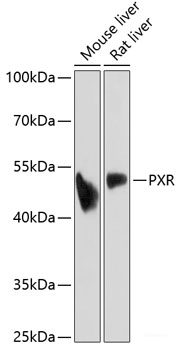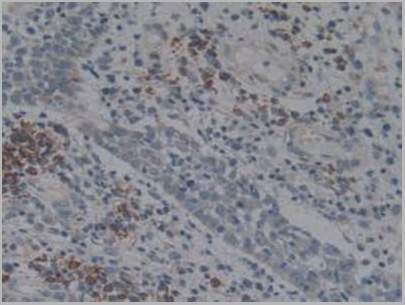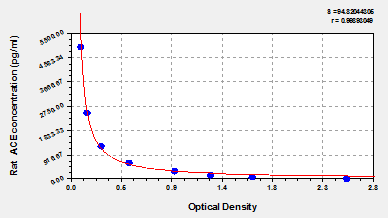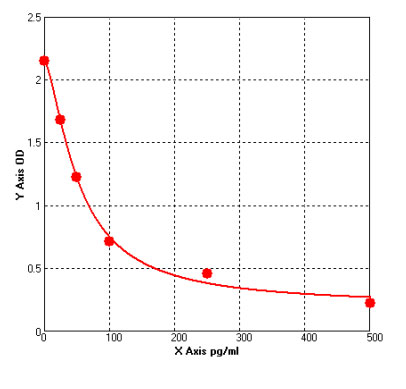Rabbit PXR Polyclonal Antibody | anti-PXR antibody
PXR Polyclonal Antibody
Gene Names
NR1I2; BXR; PAR; PRR; PXR; SAR; SXR; ONR1; PAR1; PAR2; PARq
Reactivity
Human, Mouse, Rat
Applications
Immunofluorescence, Western Blot
Purity
Affinity purification
Synonyms
PXR, Antibody; PXR Polyclonal Antibody; NR1I2; BXR; ONR1; PAR; PAR1; PAR2; PARq; PRR; PXR; SAR; SXR; anti-PXR antibody
Host
Rabbit
Reactivity
Human, Mouse, Rat
Clonality
Polyclonal
Isotype
IgG
Purity/Purification
Affinity purification
Form/Format
PBS with 0.02% sodium azide, 50% glycerol, pH7.3
Concentration
1mg/mL (varies by lot)
Applicable Applications for anti-PXR antibody
IF (Immunofluorescence), WB (Western Blot)
Immunogen
Recombinant protein of human PXR
Conjugation
Unconjugated
Preparation and Storage
Store at -20 degree C. Avoid freeze/thaw cycles.
Related Product Information for anti-PXR antibody
This gene product belongs to the nuclear receptor superfamily, members of which are transcription factors characterized by a ligand-binding domain and a DNA-binding domain. The encoded protein is a transcriptional regulator of the cytochrome P450 gene CYP3A4, binding to the response element of the CYP3A4 promoter as a heterodimer with the 9-cis retinoic acid receptor RXR. It is activated by a range of compounds that induce CYP3A4, including dexamethasone and rifampicin. Several alternatively spliced transcripts encoding different isoforms, some of which use non-AUG (CUG) translation initiation codon, have been described for this gene. Additional transcript variants exist, however, they have not been fully characterized.
Product Categories/Family for anti-PXR antibody
NCBI and Uniprot Product Information
NCBI GI #
NCBI GeneID
NCBI Accession #
NCBI GenBank Nucleotide #
UniProt Accession #
Molecular Weight
49,762 Da
NCBI Official Full Name
nuclear receptor subfamily 1 group I member 2 isoform 1
NCBI Official Synonym Full Names
nuclear receptor subfamily 1, group I, member 2
NCBI Official Symbol
NR1I2
NCBI Official Synonym Symbols
BXR; PAR; PRR; PXR; SAR; SXR; ONR1; PAR1; PAR2; PARq
NCBI Protein Information
nuclear receptor subfamily 1 group I member 2; pregnane X receptor; orphan nuclear receptor PXR; orphan nuclear receptor PAR1; steroid and xenobiotic receptor; pregnane X nuclear receptor variant 2
UniProt Protein Name
Nuclear receptor subfamily 1 group I member 2
UniProt Gene Name
NR1I2
UniProt Synonym Gene Names
PXR; SXR
UniProt Entry Name
NR1I2_HUMAN
Similar Products
Product Notes
The PXR nr1i2 (Catalog #AAA177457) is an Antibody produced from Rabbit and is intended for research purposes only. The product is available for immediate purchase. The PXR Polyclonal Antibody reacts with Human, Mouse, Rat and may cross-react with other species as described in the data sheet. AAA Biotech's PXR can be used in a range of immunoassay formats including, but not limited to, IF (Immunofluorescence), WB (Western Blot). Researchers should empirically determine the suitability of the PXR nr1i2 for an application not listed in the data sheet. Researchers commonly develop new applications and it is an integral, important part of the investigative research process. It is sometimes possible for the material contained within the vial of "PXR, Polyclonal Antibody" to become dispersed throughout the inside of the vial, particularly around the seal of said vial, during shipment and storage. We always suggest centrifuging these vials to consolidate all of the liquid away from the lid and to the bottom of the vial prior to opening. Please be advised that certain products may require dry ice for shipping and that, if this is the case, an additional dry ice fee may also be required.Precautions
All products in the AAA Biotech catalog are strictly for research-use only, and are absolutely not suitable for use in any sort of medical, therapeutic, prophylactic, in-vivo, or diagnostic capacity. By purchasing a product from AAA Biotech, you are explicitly certifying that said products will be properly tested and used in line with industry standard. AAA Biotech and its authorized distribution partners reserve the right to refuse to fulfill any order if we have any indication that a purchaser may be intending to use a product outside of our accepted criteria.Disclaimer
Though we do strive to guarantee the information represented in this datasheet, AAA Biotech cannot be held responsible for any oversights or imprecisions. AAA Biotech reserves the right to adjust any aspect of this datasheet at any time and without notice. It is the responsibility of the customer to inform AAA Biotech of any product performance issues observed or experienced within 30 days of receipt of said product. To see additional details on this or any of our other policies, please see our Terms & Conditions page.Item has been added to Shopping Cart
If you are ready to order, navigate to Shopping Cart and get ready to checkout.






















